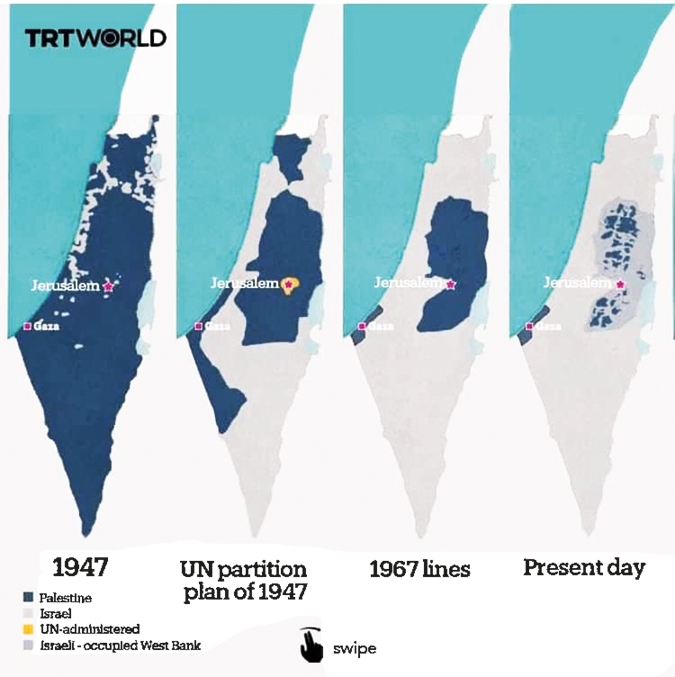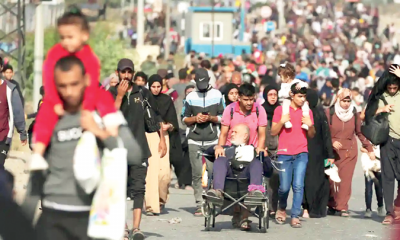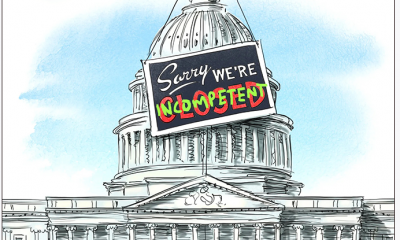Features
BIDEN’S COURAGEOUS VISIT TO ISRAEL ENDS IN ALMOST COMPLETE FAILURE

by Vijaya Chandrasoma
War does not determine who is right. Only who is left. Bertrand Russel
Saturday, October 7, 2023 was yet another Day that will live in Infamy, like December 7, 1941, when US President Roosevelt coined the phrase after the Japanese bombed Pearl Harbor, which paved the way for America’s involvement in World War II.
Prime Minister of Israel, Bibi Netanyahu, in a telephone call with President Biden before his proposed visit, said that the Hamas attack represented “savagery I can say we have not seen since the Holocaust”. Rightly so. That one day, when 2,000 Hamas terrorists butchered 700 innocent Israeli civilians and wounded hundreds more, was indeed eerily reminiscent of the atrocities committed by the Nazis against innocent Jews, men, women and children during the Holocaust.
The difference is that the Holocaust against Jews continued for least a decade, or more than 3,650 consecutive days, day after day of incredible cruelty, of torture and death. Atrocities by Nazis, not for any crime committed by Jews, but out of historic, inherent racial and religious hatred.
The Jews never forcibly tried to take possession of any land that was the homeland of Germans or any other Europeans. They simply wanted to live in peace and integrate with the Germans, and with the citizens of nations of Russia and Europe. This in spite of the regular eruption of pogroms (ethnic massacres) they endured for centuries.
During the mid-1930s, there was a significant anti-Semitic movement in the USA, which overtly endorsed Hitler’s atrocities. In fact, American national hero, Charles Lindbergh, once considered by the right wing of the Republican Party as a potential Presidential candidate in 1940, had a close relationship with Hitler and actively worked for the anti-interventionist cause. At that time, more than 80% of the American public shared his views, opposing any involvement in the European conflict. The question of going to the aid of the Jews was never on the American table.
This was until the end of the war, when the atrocities committed by the Germans, with the massacre of six million Jews and five million Europeans of “impure blood”, gassed and baked in ovens and gas chambers, were exposed to a horrified, disgusted world. Until Europeans, Americans, even some Germans felt the extreme shame of not going to the aid of these innocent victims, even though they well knew exactly what was happening in these Nazi concentration camps.
The Nazi’s “Jewish Problem” then became, out of guilt, the British and Americans’ “Jewish Problem”. They took the easy way out. They stole the land of the Palestinians by Divine Order, after which it became the Palestinians’ “Jewish Problem”.
As Pablo Casals, famed Puerto Rican cellist and conductor said, “The world is in greater peril from those who tolerate or encourage evil than those who actually commit it”.
There have been pro-Palestinian protests in cities around the world, including America, against the continuing Israeli attacks on Gaza in revenge for the Hamas atrocities on October 7. Students of prominent educational institutions in America, including Harvard, are joining worldwide protests against the injustice of land being stolen from the people of Palestine.
A historic and mostly forgotten irony has been erased from the minds of these students at Harvard University, and most Americans. They are protesting the stealing of Palestinian land by the Israelis, unaware that they are standing on land stolen by their ancestors from native Americans.
Harvard students are protesting the annexation of Palestinian land by the Israelis, so doing on land stolen from the original native American tribe of Massachusetts. A tribe that exists no longer, but endures in memory only in the name of the state.
But I digress. Going back to the gift that kept on giving, also known as the Balfour Declaration of 1917, the British committed Palestine, a country where Arabic culture, traditions and language were dominant, “to the establishment of a national home for the Jewish people”.
The Jewish people accepted the twice-promised land, gifted by both the British and the Bible (the most sacred of title deeds), and emigrated to Palestine in their thousands, fleeing centuries of European persecution.
The Divine Gift of the Promised Land proved to be fruitful. Today, 3.5 million Palestinians are confined to the narrow, 140 sq. miles of the Gaza Strip, and share the West Bank of the Jordan River in dots of settlements amongst hostile Jewish settlers. The rest of the land of Palestine, now Israel, is under the military control and occupation of the Chosen People.
The map at the top of the essay shows the progressive and illegal Israeli annexation of Palestinian land since 1947.
A Two-State solution, proposed earlier by the United Nations, seemed to be the only equitable way to end this conflict, with equitably divided sovereign states, possibly according to pre-1967 borders. Jews and Palestinians living in peace in lands neighboring each other may be an impossible dream.
The virtual genocide and displacement of the Palestinian people and the complete annexation of Palestinian land, with American assistance, is almost a fait accompli. Today, Jews, with a population of 9.7 million outnumbering 3.5 million Palestinians, occupy the major part of the “Holy Land”. So where is the Israeli need for a Two-State solution? The Jewish State, as foretold in the Bible is a virtual reality.
President Biden visited Israel last Wednesday, in a display of American solidarity with Israel. He had three major missions for this historic visit: to make possible the release of 250 hostages, including about 20 Americans, held by Hamas in Gaza; to warn other actors in the region, like Hezbollah and Iran, not to escalate the conflict; and to ensure that Israel does not imperil the human rights of innocent Palestinians in their stated motive of exacting revenge for the atrocities committed by Hamas on October 7.
The bombing of a hospital in Gaza, which killed hundreds of Palestinian civilians and patients, a war crime, changed the trajectory of Biden’s short visit even before his arrival in Tel Aviv.
The Israelis first said the hospital bombing was an airstrike targeting Hamas that went wrong; then they accused terrorists operating in Gaza, Islamic Jihad, of bombing their own hospital. The hospital bombing occurred during Israel’s intense and continuing airstrikes on North Gaza for 11 days after the Hamas attack on October 7.
As expected, Biden stands with Israel Prime Minister Bibi Netanyahu. On meeting Bibi, Biden hugged him and said he believes the Israeli version of the Gaza hospital bombing, that it was done by “the other team, not you”. The American propaganda machine is busily gathering questionable satellite evidence to absolve their allies of this dastardly attack. No Arab will accept such evidence, doctored or not.
The Israelis’ stated intention of targeting only Hamas in their strikes in Gaza is as ridiculous as it is perfidious. Hamas operatives live with Palestinian civilians, they do not wear a Scarlet Letter T on their foreheads to identify themselves as terrorists. Collective murder of innocent Palestinians in the Israeli quest for revenge is inevitable. The Israeli blockade of food, water and medical supplies in Gaza is aimed at all Palestinians, not just Hamas terrorists. The relentless bombing by the Israeli Defense Forces of the area refutes their claim that the Gaza hospital bombing was done by a stray Hamas rocket.
Finger pointing is to no avail. The damage is done. The protests of Arabs throughout the Middle-East resulting from this atrocity led to the cancellation of the scheduled summit in Jordan for President Biden with Arab leaders in the region.
Biden left Israel, with little to show for his courageous though risky visit to a war zone. He said the Americans have learnt from past mistakes; grave mistakes, when they failed to intervene as Hitler was carrying out genocide of the Jews in Germany in the 1930s; and when America overreacted after 9/11, embroiling America in an illegal war for 15 years against the wrong enemy, with enormous cost to life, property and credibility.
Biden had limited success when he persuaded Israel to temporarily open the Egyptian border and allow American humanitarian aid to reach the Palestinians in North Gaza, desperately in need of such aid of medical supplies, water and food. One million Palestinian civilians under siege to be supplied 20 trucks of emergency provisions, sufficient for maybe a few days. Whether more trucks will be allowed access is anyone’s guess.
But while Biden condemned the terrorism of Hamas, he did not demand any assurances from Netanyahu of the cessation of retaliation against innocent Palestinians in North Gaza. Nearly two weeks of airstrikes and bombings, blockage of essential supplies, which have already claimed the lives of over 4,000 innocent Palestinian men, women and children. The hostages have still not been released. He received no assurance from Netanyahu of the suspension of the imminent ground offensive in North Gaza which will endanger the lives of nearly a million Palestinian civilians. Their strategy seems to drop thousands of bombs on North Gaza, destroy everything, and follow though with a ground invasion. What is their endgame – genocide?
The Israeli offensive if allowed to take place, will escalate exponentially the risk of the conflict spreading to other regions.
In that sense, Biden’s visit was a complete failure. But a complete success for Netanyahu, who got everything for Israel and gave away almost nothing.
President Biden is making a speech to the American people from the Oval Office, as I am writing this. A moving speech, emphasizing American values, determination to support democracy wherever it is under threat. He reiterated his steadfast support of both Ukraine and Israel, valued and loyal allies. He made a request from Congress for a funding package of $100 billion to help these allies in their wars against, as he said, aggressors who threaten their very existence as sovereign nations. He is asking for funding to help them in providing weaponry for their self-defense. He has no plans of having American boots on the ground in either of these arenas.
At first and admittedly ill-considered analysis, it has to be agreed that Americans must aid their allies. However, these two allies, Ukraine and Israel, are fighting their wars in different roles. One, Ukraine, in defense of their sovereignty against the aggressor, Russia. The other, Israel, is the aggressor, putting the finishing touch on targeted genocide, completion of the annexation of the land of an erstwhile sovereign nation, Palestine. An annexation in which Americans have been complicit since the end of World War II.
One ally is the defender, the other the aggressor. But helping both, morality and justice notwithstanding, is in the best interests of the Americans. That has always been the prime American motive in all the numerous wars they have involved themselves in since World War II.
Does the fate that befell the native American tribes centuries ago, when their lands were violently stolen and they were systematically and brutally “eliminated” by Europeans, await the Palestinians? History seems to favor that ultimate outcome, in the not too distant future.
Fifty years ago, Prime Minister of Israel, Golda Meir is reputed to have told then Senator Biden on a visit to that embattled region, “You know, Senator. We have a secret weapon here, in Israel. We have no place else to go”.
The tables certainly have turned. Today, the Palestinians have been almost completely defeated in their almost century-long struggle to hold on to their land against impossible odds. They are facing imminent genocide, displacement and extinction. Neighboring Arab nations are not, as a rule, prepared to accept them as refugees. They have no secret weapon in Palestine. They have no place else to go.
Features
Echo fades? NPP’s waning momentum in LG polls

 The 2025 local government elections in Sri Lanka were expected to cement the National People’s Power (NPP) as the country’s emergent political force. However, the results delivered a more complex picture. Despite months of rising public frustration with traditional parties, the NPP saw a surprising loss of momentum—shedding over 2.3 million votes compared to their strong showing in the 2024 elections. This electoral drop has puzzled analysts and frustrated supporters, raising critical questions about political consistency, campaign strategy, and the evolving expectations of Sri Lanka’s voters.
The 2025 local government elections in Sri Lanka were expected to cement the National People’s Power (NPP) as the country’s emergent political force. However, the results delivered a more complex picture. Despite months of rising public frustration with traditional parties, the NPP saw a surprising loss of momentum—shedding over 2.3 million votes compared to their strong showing in the 2024 elections. This electoral drop has puzzled analysts and frustrated supporters, raising critical questions about political consistency, campaign strategy, and the evolving expectations of Sri Lanka’s voters.
Since 2019, the NPP, led by Anura Kumara Dissanayake, had rapidly ascended in popularity, drawing support from youth, professionals, and disillusioned citizens across ethnic and social lines. Its messaging of clean governance, economic equity, and systemic reform resonated strongly in the wake of multiple national crises—from the 2019 Easter attacks to the crippling financial collapse of 2022.
In the aftermath of President Gotabaya Rajapaksa’s resignation and widespread protests that rocked the island in 2022, the NPP emerged as a political vessel for anti-establishment sentiment. Many expected the 2025 local government elections to be a stepping-stone to national dominance. (See table 1: Source: https://election.newsfirst.lk/#/parties)
The Vote Drop Explained
* The loss of 2.3 million votes has several potential explanations:
* Turnout Fatigue: Voter turnout was markedly lower than in the presidential elections, particularly in urban centres and among younger demographics—traditionally NPP strongholds.
* Fragmented Opposition: Other opposition parties, including the SJB and remnants of SLFP factions, may have regained localised influence, especially in rural electorates.
* Unrealised Expectations: Some voters, who rallied behind the NPP in national-level discourse, may have doubted its practical ability to manage local governance.
* Campaign Gaps: Compared to the presidential elections, the local campaign lacked grassroots mobilisation and visibility in several key districts.
* Implications for Presidential Race

While the NPP remains a key contender for the next presidential election, the 2025 local poll results suggest it cannot rely solely on public dissatisfaction to drive voter loyalty. Its ability to build consistent, multi-layered support—across local, provincial, and national levels—may determine its viability as a governing force.
The results of the 2025 local government elections are neither a death knell nor a coronation for the NPP. Rather, they serve as a sobering checkpoint in the party’s political journey. The challenge now is to reconnect with its disillusioned base, sharpen its policy delivery at the grassroots, and reassert itself, not just as a movement—but as a government-in-waiting.
Sri Lanka’s 2025 local government elections mark a significant turning point in the nation’s political trajectory. After decades of domination by traditional parties, such as the United National Party (UNP), the Sri Lanka Freedom Party (SLFP), and their offshoots, a new political force—the National People’s Power (NPP)—has emerged as a credible challenger. Fuelled by public frustration over economic mismanagement, corruption, and a deepening trust deficit in governance, the NPP’s ascent signals not merely a change in voter preference but a seismic shift in political culture.
This article analyzes the key patterns emerging from the 2025 local government polls, drawing comparisons with historical voting trends from 1982 to 2024. It explores the urban-rural divide, the shifting role of ethnic minority parties, and the unprecedented surge in support for the NPP. Through this lens, we assess the long-term implications for Sri Lanka’s democratic institutions, party system, and policy direction.
Since gaining independence in 1948, Sri Lanka’s political landscape has been predominantly shaped by two major parties: the United National Party (UNP) and the Sri Lanka Freedom Party (SLFP). These parties alternated in power for decades, cultivating strong patronage networks and deep-rooted voter bases. While the UNP positioned itself as centre-right and pro-business, the SLFP leaned toward centre-left policies and a populist approach. Their dominance, however, was periodically challenged by splinter groups and coalitions, such as the Janatha Vimukthi Peramuna (JVP), Tamil political parties, and more recently, the Sri Lanka Podujana Peramuna (SLPP), founded by the Rajapaksa family.
The 1970s and 1980s were marked by political instability, including the JVP insurrections, ethnic tensions, and the outbreak of a protracted civil war in 1983. These events shifted the focus of governance toward national security and centralised power. The civil war’s end in 2009 created new political opportunities, especially for the Rajapaksas, whose military victory brought them immense popularity. The SLPP, a breakaway from the SLFP, capitalised on this sentiment to dominate national politics by 2019.
However, the veneer of stability began to crack following the Easter Sunday attacks in 2019, the economic collapse of 2022, and a series of mass protests that culminated in the resignation of President Gotabaya Rajapaksa. These events exposed the fragility of state institutions, widespread corruption, and policy incoherence. The public’s growing disillusionment with mainstream parties created fertile ground for alternative political movements.
The National People’s Power (NPP), an alliance led by the formerly radical JVP and allied civil society actors, emerged as a legitimate alternative. With a platform centred on good governance, anti-corruption, youth empowerment, and economic justice, the NPP resonated particularly with urban voters, the educated middle class, and politically disenchanted youth. Their performance in the 2025 local government elections reflects this broader national mood and demands a serious examination of whether Sri Lanka is entering a post-partisan or realigned political era.
Over the past four decades, Sri Lanka’s political stage has experienced seismic shifts — from the firm grip of traditional powerhouses, like the United National Party (UNP) and the Sri Lanka Freedom Party (SLFP), to a recent wave of public support for reformist newcomers like the National People’s Power (NPP).
From Dominance to Decline: UNP and SLFP’s Waning Appeal
In the early 1980s, the UNP was riding high, securing over half the vote in national elections. But as the years progressed, public dissatisfaction began to creep in. By 1994, after over a decade of UNP-led rule, marked by civil unrest and economic concerns, voters decisively turned to the SLFP, handing it a landslide victory with over 62% of the vote. This marked the beginning of a back-and-forth tug-of-war between the two traditional giants.
From 2005 to 2015, elections were closely fought. The SLFP, supported by a strong rural base and popular policies, held a slight edge. However, in 2015, a wave of frustration over governance saw the UNP bounce back. The contest remained tight until the SLFP once again gained ground in 2019.
2024: A System in Flux
By 2024, the grip of both the UNP and SLFP had visibly weakened. In one round of results, the SLFP led with 42.3% while the UNP lagged behind at 32.75%. In another, the gap widened even further, with the SLFP reaching nearly 56% of the vote. These figures, however, painted only part of the picture. Beneath the surface, a deeper shift was brewing — the emergence of a third force.
Urban-Rural Divide Becomes Clearer
The NPP made sweeping gains in urban areas like Colombo, Gampaha, Kalutara, and Kandy. Educated young voters, professionals, and middle-class families — hit hard by job losses and rising living costs — turned to the NPP’s promise of clean governance and reform.
In contrast, rural regions, particularly in the South and North Central areas, still leaned toward the SLPP and SJB (Samagi Jana Balawegaya), albeit with thinner margins than in previous years. Old loyalties and patronage networks seemed to persist, though weakening steadily.
Ethnic Politics and Emerging National Themes
Tamil political parties, particularly the Illankai Tamil Arasu Kachchi (ITAK), held their ground in the Northern and Eastern Provinces, winning most local seats in places like Jaffna and Batticaloa. However, voter turnout was low, signalling deep political disillusionment.
Interestingly, the NPP also made modest inroads in these regions, suggesting its message is resonating across ethnic lines, particularly among younger and more urbanised voters.
Economic Anger Fuels Political Upheaval
The steep decline of the SLPP has been linked directly to the economic crisis, where food, fuel, and medicine shortages led to the 2022–2023 protests known as Aragalaya. The ruling party’s failure to stabilise the economy appears to have cost them dearly, aligning with global trends where poor governance results in electoral punishment.
While the SJB made some gains, especially in southern regions, it couldn’t fully capitalise on voter frustration. Analysts suggest this may be due to its perceived links to the old UNP, vague policy directions, and lack of a bold vision.
End of Bipolar Politics?
The rise of the NPP signals the beginning of a new political era. For decades, Sri Lankan politics was defined by a two-party rivalry — UNP vs. SLFP, and later SLPP vs. SJB. Now, the landscape is tripolar, and possibly moving toward a multiparty democracy where ideas and reform matter more than family legacies and party loyalty.
Young, first-time voters and professionals are looking for issue-based politics: anti-corruption, economic stability, and public accountability. The NPP seems to be answering that call — for now.
A New Chapter Begins
In short, Sri Lanka is witnessing a political transformation. The old guard is losing ground. A new generation of voters is demanding answers, not slogans. And if the 2025 local elections are anything to go by, the future may well belong to those who listen, adapt, and lead with integrity.
(The writer, a senior Chartered Accountant and professional banker, is Professor at SLIIT , Malabe. He is also the author of the “Doing Social Research and Publishing Results”, a Springer publication (Singapore), and “Samaja Gaveshakaya (in Sinhala). The views and opinions expressed in this article are solely those of the author and do not necessarily reflect the official policy or position of the institution he works for. He can be contacted at saliya.a@slit.lk and www.researcher.com)
Features
A plural society requires plural governance

The local government elections that took place last week saw a consolidation of the democratic system in the country. The government followed the rules of elections to a greater extent than its recent predecessors some of whom continue to be active on the political stage. Particularly noteworthy was the absence of the large-scale abuse of state resources, both media and financial, which had become normalised under successive governments in the past four decades. Reports by independent election monitoring organisations made mention of this improvement in the country’s democratic culture.
In a world where democracy is under siege even in long-established democracies, Sri Lanka’s improvement in electoral integrity is cause for optimism. It also offers a reminder that democracy is always a work in progress, ever vulnerable to erosion and needs to be constantly fought for. The strengthening of faith in democracy as a result of these elections is encouraging. The satisfaction expressed by the political parties that contested the elections is a sign that democracy in Sri Lanka is strong. Most of them saw some improvement in their positions from which they took reassurance about their respective futures.
The local government elections also confirmed that the NPP and its core comprising the JVP are no longer at the fringes of the polity. The NPP has established itself as a mainstream party with an all-island presence, and remarkably so to a greater extent than any other political party. This was seen at the general elections, where the NPP won a majority of seats in 21 of the country’s 22 electoral districts. This was a feat no other political party has ever done. This is also a success that is challenging to replicate. At the present local government elections, the NPP was successful in retaining its all-island presence although not to the same degree.
Consolidating Support
Much attention has been given to the relative decline in the ruling party’s vote share from the 61 percent it secured in December’s general election to 43 percent in the local elections. This slippage has been interpreted by some as a sign of waning popularity. However, such a reading overlooks the broader trajectory of political change. Just three years ago, the NPP and its allied parties polled less than five percent nationally. That they now command over 40 percent of the vote represents a profound transformation in voter preferences and political culture. What is even more significant is the stability of this support base, which now surpasses that of any rival. The votes obtained by the NPP at these elections were double those of its nearest rival.
The electoral outcomes in the north and east, which were largely won by parties representing the Tamil and Muslim communities, is a warning signal that ethnic conflict lurks beneath the surface. The success of the minority parties signals the different needs and aspirations of the ethnic and religious minority electorates, and the need for the government to engage more fully with them. Apart from the problems of poverty, lack of development, inadequate access to economic resources and antipathy to excessive corruption that people of the north and east share in common with those in other parts of the country, they also have special problems that other sections of the population do not have. These would include problems of military takeover of their lands, missing persons and persons incarcerated for long periods either without trial or convictions under the draconian Prevention of Terrorism Act (which permits confessions made to security forces to be made admissible for purposes of conviction) and the long time quest for self-rule in the areas of their predominance
The government’s failure to address these longstanding issues with urgency appears to have caused disaffection in electorate in the north and east. While structural change is necessarily complex and slow, delays can be misinterpreted as disinterest or disregard, especially by minorities already accustomed to marginalisation. The lack of visible progress on issues central to minority communities fosters a sense of exclusion and deepens political divides. Even so, it is worth noting that the NPP’s vote in the north and east was not insignificant. It came despite the NPP not tailoring its message to ethnic grievances. The NPP has presented a vision of national reform grounded in shared values of justice, accountability, development, and equality.
Translating electoral gains into meaningful governance will require more than slogans. The failure to swiftly address matters deemed to be important by the people of those areas appears to have cost the NPP votes amongst the ethnic and religious minorities, but even here it is necessary to keep matters in perspective. The NPP came first in terms of seats won in two of the seven electoral districts of the north and east. They came second in five others. The fact that the NPP continued to win significant support indicates that its approach of equity in development and equal rights for all has resonance. This was despite the Tamil and Muslim parties making appeals to the electorate on nationalist or ethnic grounds.
Slow Change
Whether in the north and east or outside it, the government is perceived to be slow in delivering on its promises. In the context of the promise of system change, it can be appreciated that such a change will be resisted tooth and nail by those with vested interests in the continuation of the old system. System change will invariably be resisted at multiple levels. The problem is that the slow pace of change may be seen by ethnic and religious minorities as being due to the disregard of their interests. However, the system change is coming slow not only in the north and east, but also in the entire country.
At the general election in December last year, the NPP won an unprecedented number of parliamentary seats in both the country as well as in the north and east. But it has still to make use of its 2/3 majority to make the changes that its super majority permits it to do. With control of 267 out of 339 local councils, but without outright majorities in most, it must now engage in coalition-building and consensus-seeking if it wishes to govern at the local level. This will be a challenge for a party whose identity has long been built on principled opposition to elite patronage, corruption and abuse of power rather than to governance. General Secretary of the JVP, Tilvin Silva, has signaled a reluctance to form alliances with discredited parties but has expressed openness to working with independent candidates who share the party’s values. This position can and should be extended, especially in the north and east, to include political formations that represent minority communities and have remained outside the tainted mainstream.
In a plural and multi-ethnic society like Sri Lanka, democratic legitimacy and effective governance requires coalition-building. By engaging with locally legitimate minority parties, especially in the north and east, the NPP can engage in principled governance without compromising its core values. This needs to be extended to the local government authorities in the rest of the country as well. As the 19th century English political philosopher John Stuart Mill observed, “The worth of a state in the long run is the worth of the individuals composing it,” and in plural societies, that worth can only be realised through inclusive decision-making.
by Jehan Perera
Features
Commercialising research in Sri Lanka – not really the healthiest thing for research

In the early 2000s, a colleague, returning to Sri Lanka after a decade in a research-heavy first world university, complained to me that ‘there is no research culture in Sri Lanka’. But what exactly does having a ‘research culture’ mean? Is a lot of funding enough? What else has stopped us from working towards a productive and meaningful research culture? A concerted effort has been made to improve the research culture of state universities, though there are debates about how healthy such practices are (there is not much consideration of the same in private ‘universities’ in Sri Lanka but that is a discussion for another time). So, in the 25 years since my colleague bemoaned our situation, what has been happening?
What is a ‘research culture’?
A good research culture would be one where we – academics and students – have the resources to engage productively in research. This would mean infrastructure, training, wholesome mentoring, and that abstract thing called headspace. In a previous Kuppi column, I explained at length some of the issues we face as researchers in Sri Lankan universities, including outdated administrative regulations, poor financial resources, and such aspects. My perspective is from the social sciences, and might be different to other disciplines. Still, I feel that there are at least a few major problems that we all face.
Number one: Money is important.
Take the example American universities. Harvard University, according to Harvard Magazine, “received $686.5 million in federally sponsored research grants” for the fiscal year of 2024 but suddenly find themselves in a bind because of such funds being held back. Research funds in these universities typically goes towards building and maintenance of research labs and institutions, costs of equipment, material and other resources and stipends for graduate and other research assistants, conferences, etc. Without such an infusion of money towards research, the USA would not have been able to attracts (and keeps) the talent and brains of other countries. Without a large amount of money dedicated for research, Sri Lankan state universities, too, will not have the research culture it yearns for. Given the country’s austere economic situation, in the last several years, research funds have come mainly from self-generated funds and treasury funds. Yet, even when research funds are available (they are usually inadequate), we still have some additional problems.
Number two: Unending spools of red tape
In Sri Lankan universities red tape is endless. An MoU with a foreign research institution takes at least a year. Financial regulations surrounding the award and spending of research grants is frustrating.
Here’s a personal anecdote. In 2018, I applied for a small research grant from my university. Several months later, I was told I had been awarded it. It comes to me in installments of not more than Rs 100,000. To receive this installment, I must submit a voucher and wait a few weeks until it passes through various offices and gains various approvals. For mysterious financial reasons, asking for reimbursements is discouraged. Obviously then, if I were working on a time-sensitive study or if I needed a larger amount of money for equipment or research material, I would not be able to use this grant. MY research assistants, transcribers, etc., must be willing to wait for their payments until I receive this advance. In 2022, when I received a second advance, the red tape was even tighter. I was asked to spend the funds and settle accounts – within three weeks. ‘Should I ask my research assistants to do the work and wait a few weeks or months for payment? Or should I ask them not to do work until I get the advance and then finish it within three weeks so I can settle this advance?’ I asked in frustration.
Colleagues, who regularly use university grants, frustratedly go along with it; others may opt to work with organisations outside the university. At a university meeting, a few years ago, set up specifically to discuss how young researchers could be encouraged to do research, a group of senior researchers ended the meeting with a list of administrative and financial problems that need to be resolved if we want to foster ‘a research culture’. These are still unresolved. Here is where academic unions can intervene, though they seem to be more focused on salaries, permits and school quotas. If research is part of an academic’s role and responsibility, a research-friendly academic environment is not a privilege, but a labour issue and also impinges on academic freedom to generate new knowledge.
Number three: Instrumentalist research – a global epidemic
The quality of research is a growing concern, in Sri Lanka and globally. The competitiveness of the global research environment has produced seriously problematic phenomena, such as siphoning funding to ‘trendy’ topics, the predatory publications, predatory conferences, journal paper mills, publications with fake data, etc. Plagiarism, ghost writing and the unethical use of AI products are additional contemporary problems. In Sri Lanka, too, we can observe researchers publishing very fast – doing short studies, trying to publish quickly by sending articles to predatory journals, sending the same article to multiple journals at the same time, etc. Universities want more conferences rather than better conferences. Many universities in Sri Lanka have mandated that their doctoral candidates must publish journal articles before their thesis submission. As a consequence, novice researchers frequently fall prey to predatory journals. Universities have also encouraged faculties or departments to establish journals, which frequently have sub-par peer review.
Alongside this are short-sighted institutional changes. University Business Liankage cells, for instance, were established as part of the last World Bank loan cycle to universities. They are expected to help ‘commercialise’ research and focuses on research that can produce patents, and things that can be sold. Such narrow vision means that the broad swathe of research that is undertaken in universities are unseen and ignored, especially in the humanities and social sciences. A much larger vision could have undertaken the promotion of research rather than commercialisation of it, which can then extend to other types of research.
This brings us to the issue of what types of research is seen as ‘relevant’ or ‘useful’. This is a question that has significant repercussions. In one sense, research is an elitist endeavour. We assume that the public should trust us that public funds assigned for research will be spent on worth-while projects. Yet, not all research has an outcome that shows its worth or timeliness in the short term. Some research may not be understood other than by specialists. Therefore, funds, or time spent on some research projects, are not valued, and might seem a waste, or a privilege, until and unless a need for that knowledge suddenly arises.
A short example suffices. Since the 1970s, research on the structures of Sinhala and Sri Lankan Tamil languages (sound patterns, sentence structures of the spoken versions, etc.) have been nearly at a standstill. The interest in these topics are less, and expertise in these areas were not prioritised in the last 30 years. After all, it is not an area that can produce lucrative patents or obvious contributions to the nation’s development. But with digital technology and AI upon us, the need for systematic knowledge of these languages is sorely evident – digital technologies must be able to work in local languages to become useful to whole populations. Without a knowledge of the structures and sounds of local languages – especially the spoken varieties – people who cannot use English cannot use those devices and platforms. While providing impetus to research such structures, this need also validates utilitarian research.
This then is the problem with espousing instrumental ideologies of research. World Bank policies encourage a tying up between research and the country’s development goals. However, in a country like ours, where state policies are tied to election manifestos, the result is a set of research outputs that are tied to election cycles. If in 2019, the priority was national security, in 2025, it can be ‘Clean Sri Lanka’. Prioritising research linked to short-sighted visions of national development gains us little in the longer-term. At the same time, applying for competitive research grants internationally, which may have research agendas that are not nationally relevant, is problematic. These are issues of research ethics as well.
Concluding thoughts
In moving towards a ‘good research culture’, Sri Lankan state universities have fallen into the trap of adopting some of the problematic trends that have swept through the first world. Yet, since we are behind the times anyway, it is possible for us to see the damaging consequences of those issues, and to adopt the more fruitful processes. A slower, considerate approach to research priorities would be useful for Sri Lanka at this point. It is also a time for collective action to build a better research environment, looking at new relationships and collaborations, and mentoring in caring ways.
(Dr. Kaushalya Perera teaches at the Department of English, University of Colombo)
Kuppi is a politics and pedagogy happening on the margins of the lecture hall that parodies, subverts, and simultaneously reaffirms social hierarchies.
By Kaushalya Perera
-

 Features3 days ago
Features3 days agoSAITM Graduates Overcome Adversity, Excel Despite Challenges
-

 Business6 days ago
Business6 days agoJohn Keells Properties and MullenLowe unveil “Minutes Away”
-

 News3 days ago
News3 days agoDestined to be pope:Brother says Leo XIV always wanted to be a priest
-

 Sports3 days ago
Sports3 days agoASBC Asian U22 and Youth Boxing Championships from Monday
-

 Foreign News4 days ago
Foreign News4 days agoMexico sues Google over ‘Gulf of America’ name change
-

 Opinion6 days ago
Opinion6 days agoRatmalana: An international airport without modern navigational and landing aids
-

 Opinion3 days ago
Opinion3 days agoDrs. Navaratnam’s consultation fee three rupees NOT Rs. 300
-

 Features2 days ago
Features2 days agoChampioning Geckos, Conservation, and Cross-Disciplinary Research in Sri Lanka
























